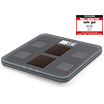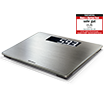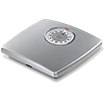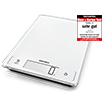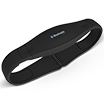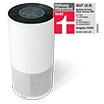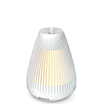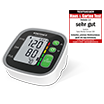Frequently Asked Questions (FAQ) -
Systo Monitor 300
Systo Monitor 300
- What is systolic blood pressure?
The systolic (top) reading is when the heart ventricles contract to pump blood out of the heart into the blood vessels.
- I am pregnant, diabetic or suffering from liver disease or cardiac arrhythmia. Can I still measure my blood pressure?
If you are pregnant, or suffer from diabetes, liver disease or cardiac arrhythmia, or wear a pacemaker, you should talk to your GP before measuring your blood pressure yourself, as in such cases the blood pressure values may be affected or distorted.
- How does my Systo blood-pressure monitoring device take measurements?
The Systo monitors are devices with state-of-the-art technology. They work using oscillometric measuring technology. The pressure variations (oscillations) resulting from the pulse waves and transmitted by the cuff are stored and evaluated by a microprocessor. The main advantage of this method is that it does not require a microphone, as these then mean the reliability of the measurement is heavily dependent on the exact positioning of the cuff.
- What is meant by the term diastolic blood pressure?
The diastolic (bottom) reading is when the heart ventricles relax and begin to refill with blood.
- Is the warranty also valid for the cuff?
Yes, the cuff is part of the product and is therefore also covered by the warranty.
- I have a very high reading: what now?
There is no need to panic. Sit calmly and repeat the measurement. Ensure you follow all the prerequisites for a precise reading. If you have another high reading, it is advisable that you visit your doctor.
- Should I take the measurement on my right or left arm?
For correct measurement, you should take test measurements on both arms and then compare the results. In future, you should take your blood pressure from the arm that showed the higher blood pressure reading.
- How long is the guarantee valid?
All Systo monitors have a two year warranty.
- Why is there a motion sensor for measuring blood pressure?
The blood-pressure monitor is very susceptible to movement and this may cause inaccurate readings. The integrated motion sensor registers all movements made while taking a measurement and points them out to the user so they can be avoided. If the Soehnle Systo Monitor registers a movement that will have an impact on the measured result, the motion sensor will abort the reading. This means you are always guaranteed reliable readings.
- At what time of day should I measure my blood pressure?
It is recommended that you monitor your blood pressure twice a day: in the mornings after you get up and in the evening, when your body is relaxed.
- What should I be aware of if I am not going to use my Systo blood-pressure monitor for a significant period of time?
To avoid damage caused by leaking batteries, please remove them if you are not going to use the device for a significant period of time.
- When should I measure my blood pressure on my wrist, and when on my upper arm?
Measuring your blood pressure on your wrist is not suitable if you have circulatory disorders or severe arteriosclerosis (arterial hardening). In such cases, blood pressure measurements should always be taken on the upper arm. Even for people without these illnesses, in isolated cases differences may occur between blood pressure measurements taken on the wrist and those taken on the upper arm. That is why occasional comparative measurements on the upper arm are recommended.
- What position should my wrist be in when taking the measurement?
Your wrist must be at heart height when taking the measurement. At the same time, your arm must not be constricted by any items of clothing that have been pushed up, and must not be moved during the measurement.
- Why does my blood-pressure monitor give me different results to those I get at the doctor?
This phenomena is known as the “white coat effect”. As a rule, people tend to be nervous when visiting their GP, and are therefore less relaxed than within their own environment or at home. Compared with measurements taken at home, results taken by a doctor tend to be somewhat higher. However, there are also people that show lower readings at the surgery than at home: their everyday stress levels mean they are calmer out of their own environment.
- Does the device need to be regularly calibrated?
Blood-pressure monitors should not be calibrated or recalibrated. However, to ensure the blood-pressure monitor is working properly, it is recommended that it be taken for a metrological control by a specialist every two years.
- What are the guidelines for systolic and diastolic pressure?
As a general rule: Upper limits: systole 140 mmHg / diastole 90 mmHg Optimum levels: systole 120 mmHg / diastole 80 mmHg For a more precise breakdown based on age, please look at the WHO table (left)
- Why do I get different results when I take two readings, one after the other?
Blood pressure is affected by a number of factors, and the circumstances are never identical when taking two sets of measurements. Moreover, factors such as operating the blood-pressure monitor and the tolerances of the measured results also play a role. That’s why individual readings only have limited value. When it comes to blood pressure, it is important to monitor your levels and make comparisons over a long period of time.
To reduce deviations in your results, you should try to:
• relax;
• not move;
• avoid flexing your muscles;
• not speak;
• avoid noise and other disturbances; and
• take your measurements at the same time and in the same place.
In addition, you should also ensure that:
• the cuff is not too loose or too tight;
• the cuff is at the same level as your heart; and
• you take a short break between two measurements. - What do I need to do when taking the measurements?
While taking measurements it is important to ensure that you:
• relax;
• do not move;
• avoid flexing your muscles;
• do not speak;
• avoid noise and other disturbances; and
• take your measurements at the same time and in the same place.
In addition, you should also ensure that:
• the cuff is not too loose or too tight;
• the cuff is at the same level as your heart; and
• you take a short break between two measurements. - How long should I wait between two measurements?
Before and between each measurement, it is important to wait for a period of five minutes, so that your mind and body can relax.
- What does the term arrhythmia mean?
All Soehnle Systo monitors are equipped with a function to detect irregular heartbeats that may indicate potential pulse arrhythmia. This can be triggered by a number of factors, such as stress, lack of sleep, etc. However, due to its complexity, any results would only be an inconclusive indication. Only a doctor can provide a reliable diagnosis.
- I am getting different results to those I get from other blood-pressure monitors.
Blood pressure is affected by a number of factors, and the circumstances are never identical when taking two sets of readings, or when they are taken on two different devices. Moreover, factors such as operating the blood-pressure monitor and the tolerances of the measured results also play a role. That’s why individual readings only have limited value. When it comes to blood pressure, it is important to monitor your levels and make comparisons over a long period of time.
To reduce deviations in your results, you should try to:
• relax;
• not move;
• avoid flexing your muscles;
• not speak;
• avoid noise and other disturbances; and
• take your measurements at the same time and in the same place.
In addition, you should also ensure that:
• the cuff is not too loose or too tight;
• the cuff is at the same level as your heart; and
• you take a short break between two measurements. - How accurate are the devices?
At temperatures between 5°C–40°C, the devices measure within a tolerance of ±3 mmHg (0.4 kPa) and with a tolerance of ±5% for the accuracy of the pulse value.
- How do I put on the cuff correctly?
1. Place the cuff on the upper arm, then turn the hose to the inside of your arm, in line with your little finger. You can also align the arterial mark so that it is placed above the largest artery (on the inside of the arm). You can find the largest artery by gently pushing 2 fingers approximately 2 cm above the crook of your arm, on the inside of your left arm. Find where the pulse can be felt the strongest. This is where the largest artery is located. 2. The cuff should be snug but not too tight. It must be possible to insert one finger between the cuff and your arm. 3. Sit in a comfortable position and place the arm on which the measurement will be taken on a level surface. Sit down comfortably prior to starting the measurement: do not cross your legs, place the soles of your feet on the floor, your back and arm should be supported. 4. For users with hypertension (high blood pressure): The centre of the cuff should be at the level of the right atrium
- What effect does negligent use have on the accuracy of the Soehnle Systo Monitor?
Negligent use leads to distortions and therefore inconclusive results. It can potentially also cause damage to the device.
- What is blood pressure?
Blood pressure is the force of your blood in your blood vessels. Blood pressure is directly dependent on cardiac output and vascular resistance. Consistently high blood pressure is a sign that the vascular resistance is too high and the heart is having to work harder.
- Can the Soehnle Systo Monitor be used with a power adapter?
The Systo Monitor 200, 300, Connect 300 and Connect 400 products can be used with an AC/DC adapter. You can order a separate adaptor via the Soehnle customer hotline (Tel.: 00 800 536 36 363). Please provide the corresponding item number when ordering. For the Systo Monitor 300, Connect 300 and Connect 400 products the item number is 89165/5, and for the Systo Monitor 200 the item number is 89166/2
- I get an error message when using the device during physical activities.
Physical movement has a direct effect on the measured result. The integrated motion sensor aborts the measuring process if it detects too much motion.
- Can I use the blood-pressure monitor despite having an irregular heart rate (cardiac arrhythmia)?
All Soehnle devices use oscillometric measuring technology. This technology is well-suited to general monitoring. However, the technology is only suitable to a limited extent for use with cardiac arrhythmia, particularly in the case of atrial fibrillation.
- What is the WHO indicator?
The WHO (World Health Organization) is an organisation founded by the United Nations that aims to improve the level of public health for everyone. Among its responsibilities are the global coordination of preventative measures and treatments for communicable diseases, and also raising awareness of and fighting against health risks such as obesity, smoking and also high blood pressure. Within the scope of these preventative measures, the WHO, together with the International Society of Hypertension, has defined a scale that is aimed at helping to provide patients with an understanding of blood-pressure values. However, only a doctor can provide a diagnosis. Important: When using the table, it is important to note that the two values may not fall within the same category. For example: You have a systolic blood pressure of 143 and a diastolic blood pressure of 86. In this case, the device would class your blood pressure as mild (light), as it always takes the higher level category. Important: Please speak to your doctor if even one of your two values (systolic or diastolic) is constantly above the limit values for hypertension (high blood pressure).

- What happens when the memory is full?
Should the memory become full, the device will delete the oldest saved value and save the new value.
- Can the Soehnle Systo devices monitor a pacemaker?
No. It is not possible to monitor a pacemaker with the Soehnle Systo Monitor, and this should only be done by a doctor or other qualified person.
- Is my Systo Monitor waterproof?
Not all Systo monitors are waterproof.
- Can I use reusable batteries?
Blood-pressure monitors need a stable power supply. Reusable batteries can fluctuate, even when fully charged, and may not be used in blood-pressure monitors.
- Can I use a different cuff?
The Soehnle blood-pressure monitor may only be used with the cuff provided.
- Can I wash the cuff?
It is recommended that you clean the cuff with a damp cloth. Cleaning under water, or in a washing machine, can damage the cuff, which could be dangerous for the user.
- Can I also use my Soehnle Systo Monitor at a low pressure?
To ensure the accuracy of the reading, it is recommended that the measurement be taken at the normal pressure.
- Can I also use the device to take measurements in the car or while flying?
We recommend you only monitor your blood pressure at home.
back to overview

